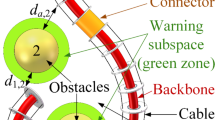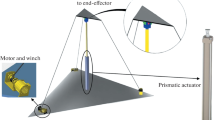Abstract
Kinodynamic planning of tensegrity robots is a thorny problem, and there are few works that have been reported on this subject, especially for tensegrity manipulators. In this study, a symplectic instantaneous optimal control (IOC) method for the obstacle-avoiding kinodynamic planning of a spinal tensegrity manipulator driven by sliding cables is first developed. This tensegrity mechanism can imitate the basic operations of the humanoid spine, such as bending, scoliosis, contraction and rotation. The actuation of sliding cables is treated as the kinematic constraints of the system inspired by the concept of multibody dynamics, so that a general dynamic model of the sliding cable-driven tensegrity robots is constructed by differential algebraic equations (DAEs). Subsequently, based on the discrete variational principle and Lagrange–d’Alembert principle, an IOC planner coupled with a symplectic penalty iteration is proposed to solve the kinodynamic planning problem of DAE systems. The proposed algorithm provides a novel unified control framework for the kinodynamic planning of tensegrity manipulators with fewer sliding cable actuators. A suboptimal collision-free path with input saturation can be planned in a complex dynamic environment where the target or the obstacles are moving. Finally, certain numerical experiments on the kinodynamic planning of a spinal tensegrity manipulator are carried out to demonstrate the effectiveness and advantages of the proposed symplectic IOC approach.






















Similar content being viewed by others
References
Motro, R.: Tensegrity: Structural Systems for the Future. Kogan Page Science, London (2003)
Sabelhaus, A.P., Li, A.H., Sover, K.A., Madden, J.R., Barkan, A.R., Agogino, A.K., Agogino, A.M.: Inverse statics optimization for compound tensegrity robots. IEEE Robot. Autom. Lett. 5(3), 3982–3989 (2020)
Aswal, N., Sen, S., Mevel, L.: Estimation of local failure in tensegrity using interacting particle-ensemble kalman filter. Mech. Syst. Signal Proc. 160, 107824 (2021)
Littlefield, Z., Surovik, D., Vespignani, M., Bruce, J., Wang, W., Bekris, K.E.: Kinodynamic planning for spherical tensegrity locomotion with effective gait primitives. Int. J. Robot. Res. 38(12–13), 1442–1462 (2019)
Paul, C., Valero-Cuevas, F.J., Lipson, H.: Design and control of tensegrity robots for locomotion. IEEE Trans. Robot. 22(5), 944–957 (2006)
Sabelhaus, A.P., Zhao, H., Zhu, E.L., Agogino, A.K., Agogino, A.M.: Model-predictive control with inverse statics optimization for tensegrity spine robots. IEEE Trans. Control Syst. Technol. 29(1), 263–277 (2021)
Tibert, A.G., Pellegrino, S.: Review of form-finding methods for tensegrity structures. Int. J. Space Struct. 26(3), 241–255 (2011)
Juan, S.H., Tur, J.M.M.: Tensegrity frameworks: static analysis review. Mech. Mach. Theory 43(7), 859–881 (2008)
Skelton, R.E., de Oliveira, M.C.: Tensegrity Systems. Springer, New York (2009)
Averseng, J., Dube, J.-F., Crosnier, B., Motro, R.: Active control of a tensegrity plane grid. In: Proceedings of the 44th IEEE Conference on Decision and Control and European Control Conference, pp. 6830–6834. Seville, Spain, (2005)
Tibert, A.G., Pellegrino, S.: Deployable tensegrity reflectors for small satellites. J. Spacecr. Rockets 39(5), 701–709 (2002)
Djouadi, S., Motro, R., Pons, J.S., Crosnier, B.: Active control of tensegrity systems. J. Aerosp. Eng. 11(2), 37–44 (1998)
Yang, S., Sultan, C.: LPV control of a tensegrity-membrane system. Mech. Syst. Signal Proc. 95, 397–424 (2017)
Zhang, M., Xinyang, G., Bruce, J., Caluwaerts, K., Vespignani, M., SunSpiral, V., Abbeel, P., Levine, S.: Deep reinforcement learning for tensegrity robot locomotion. In: Proceedings of the IEEE International Conference on Robotics and Automation, pp. 634–641. Singapore, (2017)
Wang, R., Goyal, R., Chakravorty, S., Skelton, R.E.: Model and data based approaches to the control of tensegrity robots. IEEE Robot. Autom. Lett. 5(3), 3846–3853 (2020)
Kan, Z., Li, F., Peng, H., Chen, B., Song, X.G.: Sliding cable modeling: A nonlinear complementarity function based framework. Mech. Syst. Signal Proc. 146, 107021 (2021)
Peng, J., Xu, W., Yang, T., Hu, Z., Liang, B.: Dynamic modeling and trajectory tracking control method of segmented linkage cable-driven hyper-redundant robot. Nonlinear Dyn. 101(1), 233–253 (2020)
Bel Hadj Ali, N., Rhode-Barbarigos, L., Smith, I.F.C.: Analysis of clustered tensegrity structures using a modified dynamic relaxation algorithm. Int. J. Solids Struct., 48(5), 637–647 (2011)
Kan, Z., Peng, H., Chen, B., Zhong, W.: Nonlinear dynamic and deployment analysis of clustered tensegrity structures using a positional formulation FEM. Compos. Struct. 187, 241–258 (2018)
Donald, B., Xavier, P., Canny, J., Reif, J.: Kinodynamic motion planning. J. ACM 40(5), 1048–1066 (1993)
Pinaud, J.P., Masic, M., Skelton, R.E.: Path planning for the deployment of tensegrity structures. In: Proceedings of Smart Structures and Materials Conference, pp. 436–447. San Diego, USA (2003)
van de Wijdeven, J., de Jager, B.: Shape change of tensegrity structures: Design and control. In: Proceedings of the 2005 American Control Conference, pp. 2522–2527. Portland, USA, (2005)
Hernandez Juan, S., Skelton, R.E., Mirats Tur, J.M.: Dynamically stable collision avoidance for tensegrity based robots. In: Proceedings of the ASME/IFToMM International Conference on Reconfigurable Mechanisms and Robots, pp. 315–322. London, UK (2009)
Xu, X., Sun, F., Luo, Y., Xu, Y.: Collision-free path planning of tensegrity structures. J. Struct. Eng. 140(4), 04013084 (2014)
Porta, J.M., Hernandez-Juan, S.: Path planning for active tensegrity structures. Int. J. Solids Struct. 78–79, 47–56 (2016)
Rhode-Barbarigos, L., Schulin, C., Ali, N.B.H., Motro, R., Smith, I.F.C.: Mechanism-based approach for the deployment of a tensegrity-ring module. J. Struct. Eng. 138(4), 539–548 (2012)
Sultan, C., Skelton, R. E.: Integrated design of controllable tensegrity structures. In: Proceedings of the ASME International Congress and Exposition, pp. 27−35. Dallas, TX, USA (1997)
Sultan, C., Skelton, R.: Deployment of tensegrity structures. Int. J. Solids Struct. 40(18), 4637–4657 (2003)
Aldrich, J.B., Skelton, R.E., Kreutz-Delgado, K.: Control synthesis for a class of light and agile robotic tensegrity structures. In: Proceedings of the Annual American Control Conference, pp. 5245–5251. Denver, USA (2003)
Kunkel, P., Mehrmann, V.: Differential-Algebraic Equations: Analysis and Numerical Solution. European Mathematical Society, Zürich, Switzerland (2006)
Blajer, W.: Index of differential-algebraic equations governing the dynamics of constrained mechanical systems. Appl. Math. Model. 16(2), 70–77 (1992)
Gao, Q., Tan, S.J., Zhang, H.W., Zhong, W.X.: Symplectic algorithms based on the principle of least action and generating functions. Int. J. Numer. Methods Eng. 89(4), 438–508 (2012)
Feng, K., Qin, M.: Symplectic Geometric Algorithms for Hamiltonian Systems. Zhejiang Science and Technology Publishing House, Hangzhou, China (2010)
Marsden, J.E., West, M.: Discrete mechanics and variational integrators. Acta Numer. 10, 357–514 (2001)
Arnold, V.I.: Mathematical Methods of Classical Mechanics. Springer, New York (1989)
Yang, J.N., Akbarpour, A., Ghaemmaghami, P.: New optimal-control algorithms for structural control. J. Eng. Mech. ASCE 113(9), 1369–1386 (1987)
Yang, J.N., Li, Z., Liu, S.C.: Stable controllers for instantaneous optimal control. J. Eng. Mech. ASCE 118(8), 1612–1630 (1992)
Urakubo, T.: Feedback stabilization of a nonholonomic system with potential fields: application to a two-wheeled mobile robot among obstacles. Nonlinear Dyn. 81(3), 1475–1487 (2015)
Galicki, M.: Control-based solution to inverse kinematics for mobile manipulators using penalty functions. J. Intell. Robot. Syst. 42(3), 213–238 (2005)
Junge, O., Ober-Bloebaum, S.: Optimal reconfiguration of formation flying satellites. In: Proceedings of the 44th IEEE Conference on Decision and Control and European Control Conference, pp. 66–71. Seville, Spain, (2005)
Flectcher, R.: Practical Methods of Optimization: Constrained Optimization. Wiley, Wilts, UK (1981)
Li, M., Peng, H., Zhong, W.: Optimal control of loose spacecraft formations near libration points with collision avoidance. Nonlinear Dyn. 83(4), 2241–2261 (2015)
Peng, H., Li, F., Liu, J., Ju, Z.: A symplectic instantaneous optimal control for robot trajectory tracking with differential-algebraic equation models. IEEE Trans. Ind. Electron. 67(5), 3819–3829 (2020)
Karmitsa, N., Makela, M.M.: Adaptive limited memory bundle method for bound constrained large-scale nonsmooth optimization. Optimization 59(6), 945–962 (2010)
Burke, J.V., Lewis, A.S., Overton, M.L.: A robust gradient sampling algorithm for nonsmooth, nonconvex optimization. SIAM J. Optim. 15(3), 751–779 (2005)
Lewis, A.S., Overton, M.L.: Nonsmooth optimization via quasi-Newton methods. Math. Program. 141(1–2), 135–163 (2013)
Byrd, R.H., Lu, P.H., Nocedal, J., Zhu, C.Y.: A limited memory algorithm for bound constrained optimization. SIAM J. Sci. Comput. 16(5), 1190–1208 (1995)
Acknowledgements
The authors gratefully acknowledge the financial support of the National Science Foundation of China (11922203, 11772074, 12002072) and the fellowship of China Postdoctoral Science Foundation (2020M680943).
Author information
Authors and Affiliations
Corresponding author
Ethics declarations
Conflict of interest
The authors declare that they have no conflict of interest.
Data availability statements
The data generated or analyzed during the current study are available from the corresponding author on reasonable request.
Additional information
Publisher's Note
Springer Nature remains neutral with regard to jurisdictional claims in published maps and institutional affiliations.
Appendix A
Appendix A
Taking into account Eqs. (28) and (34), it can be found that \({{\varvec{\Phi}}}_{{\varvec{x}}} = {\hat{\mathbf{\Phi }}}_{{\varvec{x}}}\). Then, each part of the Jacobian matrix shown in Eq. (36) is derived as follows:
The main terms in Eq. (A1) are \(\hat{\mathbf{\Phi }}_{{\varvec{x}}}\) and \(\frac{{\partial (\hat{\mathbf{\Phi }}_{{\varvec{x}}}^{{\text{T}}} \left( {\varvec{x}} \right) \cdot {\varvec{\lambda}}_{k + 1} )}}{{\partial {\varvec{x}}}}\), which will be presented in detail.
(1) The derivation for \({\hat{\Phi }}_{{\text{x}}}\).
According to Eq. (34), the constrained Jacobian matrix \({\hat{\Phi }}_{{\text{x}}}\) can be derived as follows:
where \(\hat{\mathbf{l}}_{i}^{{{(}j{)}}} = \frac{{{\varvec{l}}_{i}^{{{(}j{)}}} }}{{l_{i}^{{{(}j{)}}} }}\) and \({\varvec{R}}_{k}^{i}\) denote the direction vector of the jth segment and the kth nodal position vector for the ith sliding cable actuator, respectively, as presented in Fig. 1.
(2) The derivation for \(\frac{{\partial (\hat{\mathbf{\Phi }}_{{\varvec{x}}}^{{\text{T}}} \left( {\varvec{x}} \right) \cdot {\varvec{\lambda}}_{k + 1} )}}{{\partial {\varvec{x}}}}\).
Substituting Eqs. (A2) and (A3) into this item yields
where the symbol \(\mathop \Lambda \limits_{i = 1}^{m}\) denotes the assembly operation over the m sliding cable elements by the finite element method, and
where “\(\otimes\)” denotes the Kronecker product.
Rights and permissions
About this article
Cite this article
Li, F., Peng, H., Yang, H. et al. A symplectic kinodynamic planning method for cable-driven tensegrity manipulators in a dynamic environment. Nonlinear Dyn 106, 2919–2941 (2021). https://doi.org/10.1007/s11071-021-06927-w
Received:
Accepted:
Published:
Issue Date:
DOI: https://doi.org/10.1007/s11071-021-06927-w




